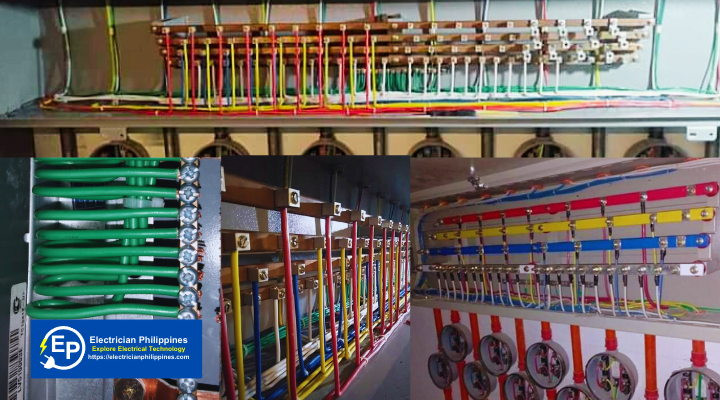
Wire management is a crucial aspect of electrical installations, particularly within panel boards where multiple wires converge and connect. Termination and wire dressing are essential steps in ensuring the safety, reliability, and efficiency of electrical systems. In this article, we will explore the significance of wire management, explore best practices for termination, and discuss the importance of wire dressing in panel boards.
Importance of Wire Management:
Effective wire management is essential for several reasons:
- Safety: Proper wire management reduces the risk of electrical hazards such as short circuits, electrical fires, and electrocution. Neatly organized wires are less prone to damage and interference, minimizing the likelihood of accidents.
- Reliability: Well-managed wiring ensures that electrical connections remain secure over time. Loose or improperly terminated wires can lead to intermittent connections or complete failures, causing disruptions and downtime.
- Efficiency: Organized wiring simplifies troubleshooting and maintenance tasks, allowing technicians to quickly identify and address issues. This enhances system uptime and productivity while minimizing downtime and repair costs.
Termination Techniques:
Termination refers to the process of connecting wires to electrical devices or components such as circuit breakers, terminal blocks, or bus bars. Proper termination is critical for ensuring secure and reliable electrical connections. Here are some commonly used termination techniques:
- Stripping and Tinning: Before termination, wires must be stripped of insulation and tinned to prevent oxidation and facilitate soldering or crimping.
- Soldering: Soldering involves melting solder onto the junction of wires and terminals to create a permanent and conductive connection. It provides excellent electrical conductivity and mechanical strength but requires skill and precision.
- Crimping: Crimping involves using a specialized tool to compress a metal sleeve or ferrule onto the stripped end of a wire and onto a terminal lug. This creates a secure and gas-tight connection without the need for soldering.
- Compression Lugs: Compression lugs are used to terminate large conductors to bus bars or other components. They feature a bolted connection that ensures high conductivity and mechanical strength.
- Insulation Displacement Connection (IDC): IDC terminals pierce the insulation of wires, making contact with the conductors inside. This method is commonly used in modular connectors and terminal blocks for quick and reliable termination.
Wire Dressing Techniques:
Wire dressing involves arranging and securing wires within a panel board to optimize space utilization, minimize interference, and enhance accessibility. Proper wire dressing facilitates maintenance and troubleshooting while improving the overall aesthetics of the installation. Here are some wire dressing techniques commonly used in panel boards:
- Bundling: Grouping wires of similar functions or routes together using cable ties, Velcro straps, or wire ducts. Bundling reduces clutter and makes it easier to trace and identify wires during maintenance.
- Routing and Routing Channels: Routing wires along predefined paths or channels within the panel board to minimize exposure to mechanical stress, heat, or electromagnetic interference. Routing channels may be integrated into the panel board enclosure or added as accessories.
- Dressing Around Components: Arranging wires neatly around components such as circuit breakers, relays, or terminal blocks to optimize space and ensure proper airflow for cooling.
- Labeling: Clearly label wires with identification tags or markers to facilitate identification and troubleshooting. Labels should be durable and easy to read, even in low-light conditions.
- Service Loops: Leaving service loops or slack in wires to accommodate future modifications or repairs without the need for rewiring or excessive strain on connections.

What is Termination and Wire Dressing?
Termination and wire dressing are crucial aspects of panel board installation and maintenance, ensuring the safety, efficiency, and reliability of electrical systems. Let’s delve into each of these practices:
Termination:
Termination refers to the process of connecting electrical conductors, such as wires or cables, to a terminal or connection point within a panel board. Proper termination is vital to ensure secure electrical connections, prevent loose connections, and minimize the risk of electrical faults, which can lead to equipment damage, downtime, or even hazards like fires or electric shocks.
Key aspects of termination include:
- Terminal Types: Panel boards typically feature various types of terminals, such as screw terminals, spring-loaded terminals, or compression terminals. The choice of terminal depends on factors like wire size, application, and specific panel board requirements.
- Wire Preparation: Before termination, it’s essential to properly strip and prepare the wire ends to ensure a clean, reliable connection. This involves removing insulation to expose the conductor without damaging it.
- Connection Techniques: Depending on the terminal type, appropriate techniques such as crimping, soldering, or simply tightening screws may be used to secure the wire to the terminal. It’s critical to follow manufacturer guidelines and industry best practices to achieve secure and reliable connections.
- Torque Specifications: Proper tightening torque is crucial to ensure adequate contact pressure without damaging the conductor or terminal. Over-tightening can deform conductors or terminals, while under-tightening can lead to loose connections and increased resistance, potentially causing overheating.
- Insulation and Protection: After termination, it’s important to insulate and protect the connection to prevent accidental contact, short circuits, or environmental damage. This may involve using insulation sleeves, heat shrink tubing, or insulating tape as appropriate.
Wire Dressing:
Wire dressing, also known as cable management or routing, involves organizing and arranging wires and cables within the panel board in a neat and orderly manner. Proper wire dressing not only enhances the aesthetics of the installation but also facilitates maintenance, troubleshooting, and future modifications by improving accessibility and reducing clutter.
Important considerations for wire dressing include:
- Routing Paths: Wires should be routed along designated paths within the panel board, following logical routes that minimize the risk of interference, abrasion, or accidental damage. Separation between power and control circuits, as well as adherence to wiring regulations and standards, should be maintained.
- Bundling and Separation: Grouping wires into bundles based on function, voltage level, or signal type can simplify identification and maintenance. However, care should be taken to avoid excessive bundling, which can lead to overheating due to restricted airflow.
- Support and Fastening: Wires should be adequately supported and fastened to prevent sagging, excessive tension, or movement that could result in fatigue failure or loosening of connections over time. Cable ties, clamps, or cable trays may be used for secure mounting.
- Clear Labeling: Proper labeling of wires, terminals, and components aids in identification during installation, maintenance, or troubleshooting. Labels should be durable, legible, and placed near the corresponding components for easy reference.
- Accessibility and Serviceability: Wire dressing should allow for easy access to terminals, components, and adjustment points within the panel board without obstructing visibility or requiring excessive disassembly. This facilitates efficient servicing and minimizes downtime during maintenance tasks.
Good Termination and Wire Dressing in Panel Boards Shows Workmanship and Professionalism
Showcasing good termination and wire dressing in panel boards not only demonstrates workmanship and professionalism but also reflects a commitment to safety, reliability, and quality in electrical installations. Here’s how these practices contribute to an impression of professionalism:
Termination:
- Precision and Neatness: Properly terminated connections exhibit a high level of precision and neatness, with wires securely fastened to terminals without excess protrusion or stray strands. This attention to detail reflects a professional approach to workmanship.
- Consistency and Uniformity: Consistent termination techniques and uniformity in wire preparation and connection methods across the panel board demonstrate a systematic and standardized approach, indicative of professionalism and adherence to best practices.
- Compliance and Standards: Following manufacturer specifications, industry standards, and regulatory requirements for termination ensures compliance with safety and quality standards, reinforcing the professionalism and credibility of the installer.
- Documentation and Record-keeping: Maintaining accurate documentation of termination procedures, including torque specifications, wire sizes, and testing results, not only supports accountability but also demonstrates a professional commitment to thoroughness and traceability.
Wire Dressing:
- Organization and Tidiness: Well-organized wire dressing, with neatly routed and secured cables, conveys a sense of orderliness and attention to detail, which are hallmark traits of professionalism. A tidy wiring layout enhances the visual appeal of the panel board and instills confidence in the quality of workmanship.
- Accessibility and Serviceability: Thoughtful wire dressing that allows for easy access to components, terminals, and adjustment points underscores a professional consideration for future maintenance, troubleshooting, and serviceability. Accessibility is essential for efficient operations and reflects a customer-centric approach.
- Durability and Longevity: Properly supported and protected wiring, with adequate strain relief and insulation, demonstrates a professional understanding of durability and longevity requirements. By mitigating risks of damage, wear, or degradation over time, robust wire dressing contributes to the reliability and longevity of the electrical installation.
- Labeling and Identification: Clear and legible labeling of wires, terminals, and components enhances the professional appearance of the panel board while facilitating ease of identification during installation, maintenance, or repair activities. Well-labeled wiring instills confidence in the integrity and professionalism of the installation.
Conclusion:
In conclusion, effective wire management, including termination and wire dressing, is essential for ensuring the safety, reliability, and efficiency of electrical panel boards. By following best practices for termination and implementing proper wire dressing techniques, electrical professionals can optimize system performance, minimize downtime, and enhance overall safety. Regular inspections and maintenance are also important to ensure that wire management practices remain effective over time.






